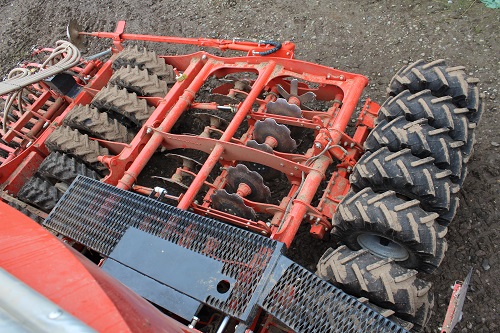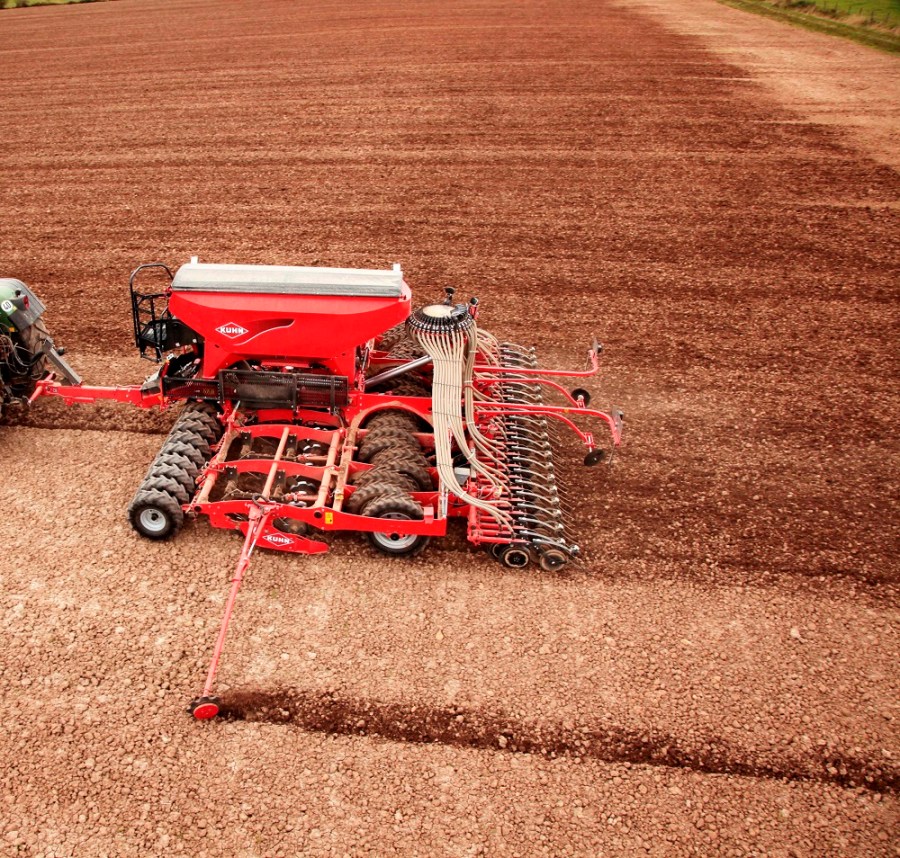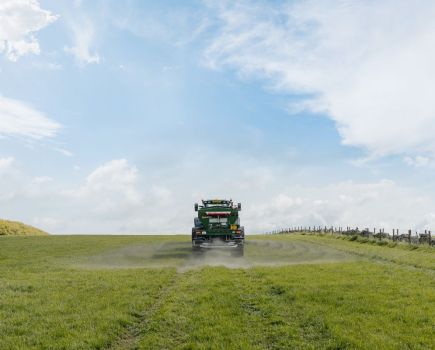When your crops range from direct-drilled stubble turnips to maize into ploughed land, you may have to look beyond the usual go-to min-till cultivator disc drills. CPM visits a contractor who opted for Kuhn’s recently launched Espro.
We wanted to do a lot of work directly into ploughed ground, as well as min-till.
By James Andrews
Stepping away from the established models is a brave move when investing the thick end of £70,000 in a new seed drill.
But when it came to buying a new machine to plant crops for his sizable AD operation, Hants contactor Steve Shutler decided to do just that.

There’s an optional full-width front tyre press while larger-diameter staggered rear press wheels are offset to make the drill easier to pull.
After considering and dismissing various options, including the ever-popular Väderstad Rapid, he got wind of Kuhn’s Espro, which had only recently been introduced to the UK market.
Like the Väderstad Rapid System Disc drills, this uses a twin set of discs to cultivate the ground before a disc coulter places the seed. However, it has a couple of features that made it appeal to him over the old-timer.
“We used to get all our drilling done by a contractor who had a Väderstad Rapid, which did a perfectly good job,” says Steve Shutler.
“However, because we wanted to do a lot of work directly into ploughed ground, as well as min-till, we thought we’d look for a machine with a decent front packer to consolidate the ground before the discs went through.”
The Espro immediately appealed as it had an optional full-width front tyre press and, as an added bonus, his local dealer New Forest Farm Machinery sold Kuhn equipment.

Tri Counties Biogas were looking for a drill that would do a lot of work directly into ploughed ground, as well as min-till.
He also liked the fact it had more aggressive discs than the Väderstad and larger-diameter staggered rear press wheels that were offset in a bid to make the drill easier to pull.
While he was weighing up his options, Kuhn’s 6m UK demonstrator Espro came up for sale, which had done very little work. Through his dealer, he managed to do a deal and secure it for a shade under £70,000.
The drill arrived on the farm in spring 2015 and was handed to Steve Shutler’s brother Phil who was tasked with setting it up and using it to establish a triticale, rye and black oats wholecrop mix.
The first thing Phil Shutler noticed was how easy the drill was to calibrate and how accurate the metering system stuck to that calibration.
“You just type the target seed rate into the screen and there’s a really useful seeding simulation function to check it’s accurate before you start drilling,” he says.
“This winds out a set area’s worth of seed into the calibration bag automatically, which you can weigh – you can then tweak the settings if you need to.”
However, it was just about spot on most of the time, so he didn’t need to touch it.
In total, Phil Shutler established 250ha of the wholecrop mix, much of which was planted straight on to furrows.
This is where the drill’s front press came into its own. “I’ve done a lot of work with different drills of this type and they always seem to struggle in loose ground as there’s too much soil going through the discs,” he says.
“But the Kuhn’s front packer pushes the ground down nice and tight, giving the discs a flat and even surface to work on.”
Packer pressure can also be adjusted to get it just right for the conditions, he adds.
The rest of the spring’s drilling was done behind the farm’s 3.8m Simba Solo which had been set to work about 10cm deep.
Here the Espro’s aggressive 460mm discs did a particularly good job of mixing the soil and burying any surface trash.
They also did surprisingly well at creating a seedbed in poor soil conditions. “In the past I’ve found that this type of drill struggles to get a fine enough tilth in rough knobbly soils and you end up with a good bit of seed on the surface,” says Steve Shutler.
“But even though we got caught out in some pretty horrible, wet conditions the drill didn’t block up and we managed to bury the seed.”
As well as the triticale, rye and back oats mix, they used the drill to plant 200ha of straight spring rye and 80ha of spring triticale, bringing the total workload in its first spring up to 530ha.
For the 2016 season the drill has also been drilling stubble turnips directly into ground that has been injected with digestate from the AD plant, says Steve Shutler. “Even here, it’s made a good seedbed – we put the digestate in at 100-125mm deep then scratched the stubble turnips in fairly shallow and they’ve come up really well.”
During the spring drilling campaign the 6m Espro was hooked to a hired 210hp John Deere 6210R that was just up to the job of pulling it.
In medium soils on fairly flat terrain it would happily charge along at 12-15km/h and it topped out at around 17km/h in particularly light soils. That meant he could easily cover more than 50ha in a day.
However, when it got into heavier, hillier ground it was just about on the limit in terms of power and grip, and it would start to wind the fuel in fairly swiftly, too.
For the 2016 season, it’s been hooked to a 300hp Case Optum 300 which toys with it in almost all conditions and uses considerably less fuel in tough going.
The Trimble-based Centrepoint RTX guidance on the Case also proved to be a good bit more reliable than the John Deere’s Greenstar SF2 signal, reckons Steve Shutler.
However, he still likes to use the markers as a backup. “It gives you a point to aim for when you’re bringing the tractor back into line before activating the auto-steer too.”
Kuhn has also concentrated on making life a little easier for the operator, he says.
Firstly, the drill’s built-in headland management system and joystick controller makes it simple to tune when each part of the drill goes into work.
“We had it set so that at the push of the button the front packer would drop in first, followed by the discs, and the coulters would hit the ground just as the seed had reached them,” says Steve Shutler.
“That meant we had no lag time before the drill started seeding and we were never dropping seed into unworked ground.”
The joystick also has quick access buttons for tweaking various elements on the move without interrupting its automatic sequence. “That means you can do things like flick one of the markers out of the way when you get to a tree or move the packer when you get to a lump.”
His only grumble was that the VT 50 in-cab screen wasn’t quite big enough to see all the settings clearly. “I did run it through ISOBUS for a bit so it came up on the tractor’s monitor, but in the end, I got fed up with flicking between the GPS and drill run screens all the time,” he says.
“I’m not convinced that you get as many functions through ISOBUS as you do with the drill’s own screen either.”
On the road, the Espro also pulls particularly smoothly for such a big heavy machine. That’s largely because the centre of the packer lifts out of the way so it’s only running on four tyres on each side, says Steve Shutler.
“That means it doesn’t rock around as you drive over contours in the road like drills that run on more tyres,” he says. “This is really important for us as we operate over a radius of more than 50 miles.”
Although the drill performed well in a range of crops and conditions it did take a bit of fettling to get it running as it should.
Firstly, when Phil Shutler set off drilling his triticale, rye and black oats mix he hadn’t realised that he needed to engage the hopper agitator. This is switched on by slotting in a plastic gear in the metering mechanism and wouldn’t be required for drilling cereals or pulses.
However, due to the varying seed sizes in the wholecrop mix, it wasn’t feeding into the metering system properly and was causing the seed rate to vary slightly across the field.
“Luckily it wasn’t fluctuating enough for you to notice a huge difference once the crop came up, but when we got the agitator running it was bang on,” he says.
He also had to play around to get the wing pressures balanced correctly so that the drill would plant at a consistent depth across its entire width.
In a bid to make it easier for the operator to adjust depth, the Espro only has depth shims on the outer rams with the middle ones linked hydraulically so that they mirror the movement of the outer rams. But they weren’t quite working as they should.
“It’s a great idea and makes the drill much quicker to adjust, but with no physical stop on the middle rams, you need to make sure you’ve got the correct amount of pressure in the system,” he says.
“In heavier soils we were upping it to around 50bar, and we were backing it off to 30bar or less in some of the lighter ground.”
However, once this was set up properly, seed depth was very consistent across the entire width of the drill.
The Espro also had a couple of minor breakdowns. Firstly, a couple of the tramline actuators broke so that seed was still dribbling downs the tubes when tramlining.
The solenoid on the pre-emergence markers also played up, but the replacement that the dealer fitted has been fine since.
Next spring Steve Shutler hopes to use the drill for establishing maize. At the moment, all maize destined for the AD plant is sown by a local contractor who uses an eight-row Kverneland/Accord Optima precision drill.
But because the Espro’s metering system is so accurate, he reckons it’ll be up to the job and will cover the ground considerably faster.
The plan is to block off every fifth coulter using the levers in the distribution head, says Steve Shutler. “Thankfully Kuhn has made this really easy as every coulter is numbered and there’s a corresponding number on the distribution head, so there’s no guess work when you’re blocking off pipes.”
He reckons he won’t need to make any other modifications to the drill, but is planning to drop drilling speed to 8-9km/h to make sure it’s as accurate as possible.
“That’s still a good bit faster than a precision planter that would run at a maximum of 7km/h or 5-6km/h in tough conditions,” he says.
Tech Specs: Tri Counties Biogas’ Kuhn Espro drill
- Model: Espro 6000 R
- Working width: 6m
- Transport width: 3m
- Hopper size: 3,500-litres
- Coulters: 40 Crossflex double-disc coulters
- Row spacing: 15cm
- Weight: 8t
- Pulled by: John Deere 6210R or Case Optum 300
- Price paid: £70,000
How the Kuhn Espro works
The Kuhn Espro uses a twin set of 460mm angled discs to work up a seedbed which is then consolidated using a set of 900mm press wheels. These are offset by 200mm to prevent them creating a bow wave of soil and to make the drill easier to pull.
Behind the press wheels sit two rows of double-disc, independently mounted Crossflex coulters, which each have their own rubber press wheel to close the slot cut by the disc.
Finally, there’s a following harrow to texture the surface, which can be adjusted to make it more or less aggressive.
The drill can also be fitted with a front tyre packer for working in ploughed ground and loose conditions.
Business breakdown
Tri Counties Biogas, Glebe Farm, West Dean, Salisbury
- Farming: 200ha of grass running a 200-head sucker herd
- Contracting: Supplying 100,000t of forage to a 6MW AD plant in Hants
- Cropping: 3100ha mixed wholecrop silage (530ha planted in-house); 2500ha maize
- Staff: Seven full-time plus 15 seasonal
- Foragers: John Deere 8800i and 8600i
- Tractors: John Deere 8370R, 6215R, 6150R, New Holland T7.270, Case Optum 300
- Tankers: Veenhuis 30cu m,18.5cu m and 11 cu m
- Cultivation: Gregoire Besson 5f plough, 3.8m Simba Solo
- Drill: 6m Kuhn Espro 6000R
- Sprayer: Berthoud 24m trailed
- HGVs: 5x Mercedes Actros 2548




